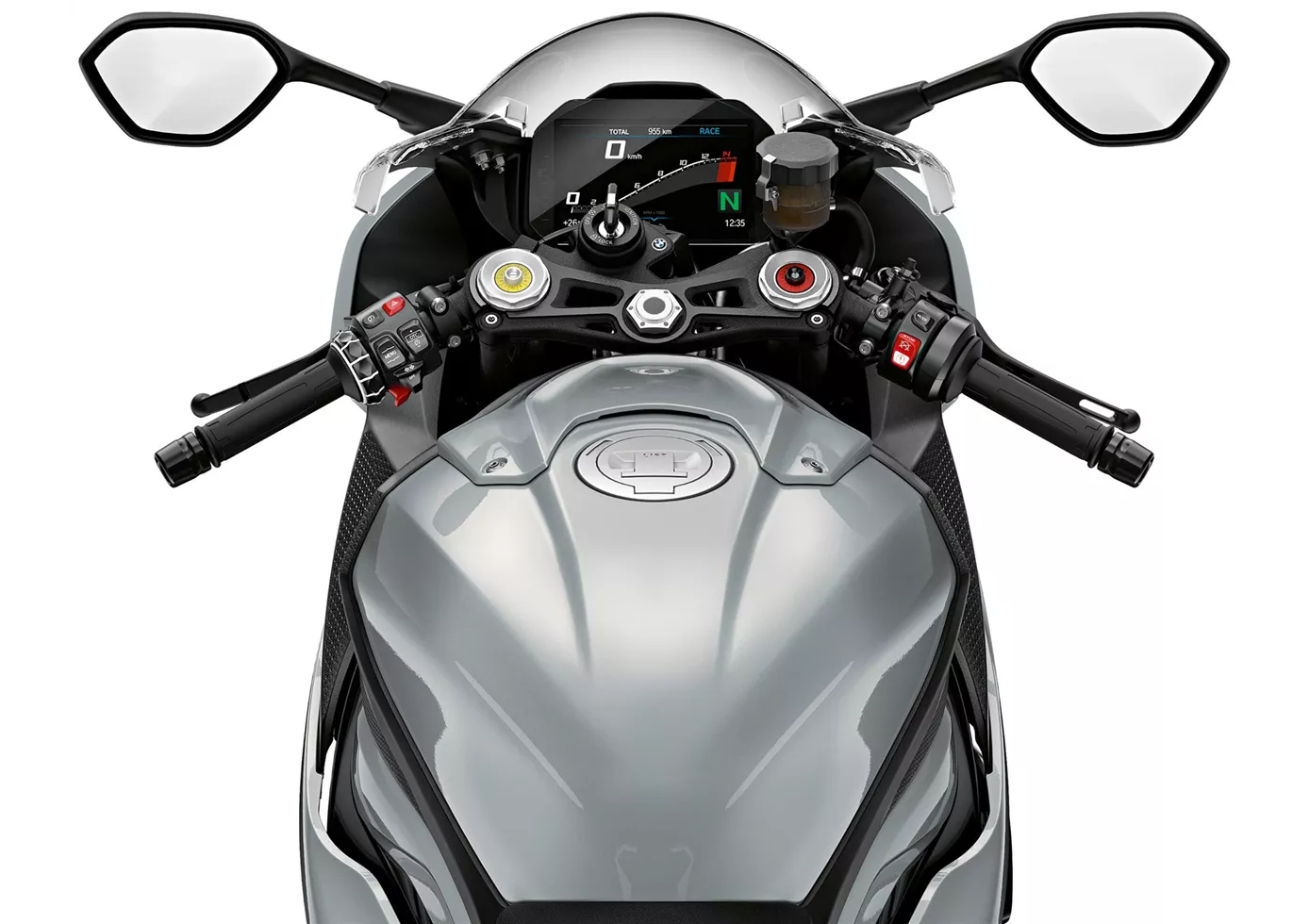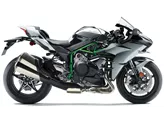BMW S 1000 R 2015 vs. BMW S 1000 RR 2020

BMW S 1000 R 2015

BMW S 1000 RR 2020
Vue d’ensemble - BMW S 1000 R 2015 vs BMW S 1000 RR 2020
The BMW S 1000 R model year 2015 and the BMW S 1000 RR model year 2020 are both impressive motorcycles from BMW, but they have some notable differences.
Starting with the BMW S 1000 R 2015, it is a naked bike with a powerful and well-controllable engine. It features an in-line four-cylinder engine with a displacement of 999cc. The engine produces 160 horsepower and 112 Nm of torque, providing excellent acceleration and top speed. The compression ratio is 12, ensuring efficient combustion. The bike has a comfortable seating position, making it suitable for longer rides. The suspension consists of an upside-down telescopic fork at the front and a swing arm with a monoshock at the rear, providing a smooth and stable ride. The chassis is made of aluminum and has a twin-tube frame, offering strength and agility. The braking system consists of double disc brakes at the front with four-piston calipers and radial technology, ensuring powerful and precise braking. The bike also features advanced rider assistance systems, including dynamic suspension. The dimensions and weights include a front tire width of 120 mm, a rear tire width of 190 mm, a wheelbase of 1439 mm, a seat height of 814 mm, a kerb weight of 207 kg (with ABS), and a fuel tank capacity of 17.5 liters.

BMW S 1000 R 2015
On the other hand, the BMW S 1000 RR 2020 is a supersport motorcycle with even more impressive performance. It also has an in-line four-cylinder engine with a displacement of 999cc, but it produces 207 horsepower and 113 Nm of torque, making it significantly more powerful than the S 1000 R 2015. The engine has a higher compression ratio of 13.3, allowing for even more efficient combustion. The bike has a wide rev range and a linear power delivery, making it highly controllable. It features ShiftCam technology, which provides plenty of pressure in the lower rev range. The suspension setup is similar to the S 1000 R 2015, with an upside-down telescopic fork at the front and a swing arm with a monoshock at the rear. The chassis is also made of aluminum and has a twin-tube design, but it is a load-bearing engine frame, offering increased rigidity and stability. The braking system is the same as the S 1000 R 2015, with double disc brakes at the front and four-piston calipers with radial technology. However, the S 1000 RR 2020 also includes advanced rider assistance systems such as ABS, riding modes, launch control, ride by wire, quickshifter, and traction control. The dimensions and weights are slightly different, with a front tire width of 120 mm, a rear tire width of 190 mm, a wheelbase of 1441 mm, a seat height of 824 mm, a kerb weight of 197 kg (with ABS), and a fuel tank capacity of 16.5 liters.
In terms of strengths, the BMW S 1000 R 2015 is praised for its powerful and controllable engine, powerful braking system, and comparatively comfortable seating position. On the other hand, the BMW S 1000 RR 2020 is praised for its very linear power delivery, wide rev range, and pleasant control. The ShiftCam technology provides plenty of pressure in the lower rev range, and the bike has an excellent DDC suspension system, precise handling, and top performance. It also has a comprehensive electronics package and is considered a harmonious overall package for both road and racetrack use.

BMW S 1000 RR 2020
Regarding weaknesses, the BMW S 1000 R 2015 is criticized for its expensive optional extras, hard chassis, and vibrations in the handlebars. On the other hand, the BMW S 1000 RR 2020 is considered a bit "characterless" compared to other bikes like the Aprilia and Honda. It also lags behind on the spec sheet in some aspects when directly compared to its competitors.
In conclusion, both the BMW S 1000 R 2015 and the BMW S 1000 RR 2020 are impressive motorcycles with their own strengths and weaknesses. The S 1000 R 2015 offers a powerful and controllable naked bike experience, while the S 1000 RR 2020 takes performance to the next level with its supersport capabilities and advanced electronics package.
Caractéristiques techniques BMW S 1000 R 2015 par rapport à BMW S 1000 RR 2020
Avantages et inconvénients en comparaison
Avantages et inconvénients en comparaison
BMW S 1000 R 2015

Sur la BMW S 1000 R, on remarque à la fois la parenté étroite avec la Superbike S 1000 RR et la volonté de doter la machine d'un niveau de confort élevé pour la route et le quotidien. Le moteur quatre cylindres de 1000 cm3 se met donc au travail de manière brutale, tout en restant bien contrôlable, et la position de conduite est par conséquent confortable et sportive. Le fait que la S 1000 R soit l'une des power naked bikes les plus abordables est surprenant et réjouissant, mais il ne faut pas pour autant mettre la main sur la liste des équipements spéciaux - car grâce aux nombreuses caractéristiques irrésistibles, elle sera certainement plus chère.
BMW S 1000 RR 2020

Une vraie superbike "à tout faire". Sur la piste de course comme sur la route, la BMW sait jouer de ses atouts. Grâce à la distribution variable de l'arbre à cames, le moteur puissant est déjà convaincant à bas régime et accélère harmonieusement sur toute la plage de régime, avec une puissance élevée dans tous les domaines. Pour le pilote amateur, le châssis fonctionne certainement de manière exceptionnelle dans toutes les situations, il garantit un feedback transparent et offre de nombreuses possibilités de réglage. La position de conduite est sportive, mais relativement confortable. L'électronique fonctionne de manière très harmonieuse sans infantiliser le pilote - TOP !
Comparaison des prix Prix moyen du marché BMW S 1000 R vs BMW S 1000 RR
There are a few key differences between a BMW S 1000 R 2015 and a BMW S 1000 RR 2020. In terms of price, the actual average price of a BMW S 1000 RR 2020 is about 94% higher. A BMW S 1000 R 2015 experiences a loss of 250 USD in one year and 600 USD in two years of ownership. This is offset by a loss of 430 USD and 140 USD for a BMW S 1000 RR 2020. Compared to BMW S 1000 RR 2020 there are less BMW S 1000 R 2015 bikes available on the 1000PS.de Marketplace, specifically 12 compared to 16. It takes less time to sell a BMW S 1000 R with 61 days compared to 68 days for a BMW S 1000 RR. Since model year 2014 1000PS.de editors have written 62 reviews for the BMW S 1000 R and 135 reviews for the BMW S 1000 RR since model year 2010. The first review for the BMW S 1000 R was published on 11/3/2013 and now has more than 17,300 views. This compares to more than 4,000 views for the first review on BMW S 1000 RR published on 4/16/2008.























